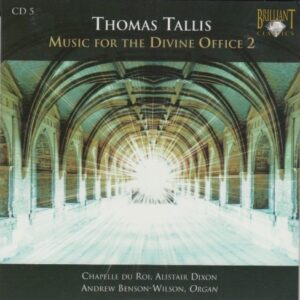 My mood today mirrors the overcast skies here in West Michigan.
My mood today mirrors the overcast skies here in West Michigan.
And Thomas Tallis isn’t helping matters much.
I’ve discovered that a little Tallis goes a very long way. However, by Day 5 CD 5, I’ve experienced a lot of Tallis.
The cumulative result of a lot of Tallis is that it all sounds the same, much like a lot of ancient music does.
The one time I tried getting through the complete works of Bach, I nearly poked my ears out with pencils because I couldn’t take one more minute of harpsichord music, track after track of it. I had to switch to an edition of Bach that didn’t use period instruments. The piano is much more enjoyable than a harpsichord, let me tell you.
This is how I’m starting to feel about Tallis. It all sounds the same. No way for me to, at least at this point, discern which track I’m on or even which CD I’m listening to.
The liner notes to this set are superb, however. Author Nick Sandon brings to life these ancient songs in a way that makes even their sameness seem fascinating. For example, Sandon writes,
CD 5
Music for the Divine Office 2This fifth CD of music by Tallis contains the choral hymns and responsories not included in CD 4. It is completed by Tallis’s liturgical organ music: five hymns and three antiphons for the Divine Office, an Alleluia for the Lady Mass and an extended setting of the offertory Felix namque.
Choral hymns and responds
The context in which Tallis and his contemporaries turned to the composition of hymns and responsories was described in the notes to CD 4 of this series. Tallis’s approach to composing these liturgical items was methodical but inventive. The hymns are essentially settings of the original plainchant melodies. When sung entirely in plainchant, hymns are performed alternatim, the two sides of the choir singing alternate verses to the same melody. Tallis preserved this alternatim structure by setting only the even-numbered verses and usually also the doxology in polyphony, leaving the other verses to be sung to the original chant.
That level of scholarship and joy for the subject matter is rare these da ys. But it’s par for the course at Brilliant Classics, a record label that never disappoints.
ys. But it’s par for the course at Brilliant Classics, a record label that never disappoints.
Still, my ears are weary of this sameness. I enjoy the organ music. I enjoy the monastic-sounding vocals. But I need something with more pep and punch to it this morning, or else I’m going to doze off.
Like what?
Like, maybe the Canadian Prog Rock band Mystery. The very second I discovered Mystery, I was hooked. The product is exquisite. The songs are complex, creative, and just plain beautifu, as are the lyrics and soaring vocals.
Or the Swedish melodic death metal band Amon Amarth. I’m not a fan of “Cookie-Monster” vocals. But I like the melodic part and the metal part.
The point is, when I listen to music, I want to hear differences in sound, especially from track to track. I want melodies and highs and lows, fast and slows.
I realize Thomas Tallis was writing for a very different reason in a very different historical period.
Just the Facts
CD 5 of this 10-CD box set consists of 18 tracks that clock in at one hour and 18 minutes.
As with the previous four CDs, the music on this one was performed by Chapelle du Roi, conducted by Alistair Dixon.
Just the Feelings
Recording quality: 5
Overall musicianship/vocals: 5
CD liner notes: 5
How does this make me feel: 3
As I mentioned, I’m getting Tallis fatigue. Chapelle du Roi and Alistair Dixon did a superlative job bringing this ancient music to life. No doubt about it.
If I wanted music to soothe me or allow my spirit to feel uplifted, I’d be hard pressed to find music more adept at doing both. But sometimes I would like my spirit and my mood to be invigorated. Like when I listen to Christian Rock or Metal. Great lyrics plus music that doesn’t lull me into a stupor.
Your mileage may vary.
